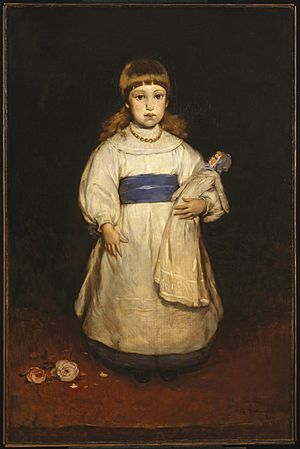Mary Cabot Wheelwright facts for kids
Mary Cabot Wheelwright was an American anthropologist who founded a museum. She was born on October 2, 1878, and passed away on July 29, 1958. In 1937, she started the Wheelwright Museum of the American Indian with Hosteen Klah. This museum helps preserve and share the rich culture of Native American people.
Contents
Early Life and Family Background
Mary Cabot Wheelwright was born in Boston on October 2, 1878. She was the only child of Andrew Cunningham Wheelwright and Sarah Perkins Cabot Wheelwright. Mary grew up in a very wealthy family. Her family, the Cabot family, was a well-known part of Boston's upper class.
Her family's wealth came from their ancestors, who were successful merchants in the 1700s. They became rich through shipping and trade. Mary's mother, Sarah, was a close friend of the famous writer Ralph Waldo Emerson. He often visited their home. Mary was raised with ideas from the Transcendentalist movement and the Unitarian Church.
When Mary was four years old, in 1882, she posed for a portrait. This painting was done by the American artist Frank Duveneck. Mary traveled a lot with her parents. They visited places like Europe, Egypt, and California. Her parents were very protective of her.
For about 40 years, Mary lived as a "dutiful Victorian daughter." She spent her time doing good deeds. One of her main activities was helping a music school in Boston. She had a lot of money from a family trust. This money supported her throughout her life. However, she could not fully control the main capital. This was meant to protect her, but it also meant she couldn't give as much money to her future museum as she wished.
Discovering the American Southwest
When Mary was 40, both of her parents had passed away. She then traveled to the American Southwest. There, she found a new way of life that was more exciting than her safe life in Boston. She stayed on a ranch in Alcalde, New Mexico. She also visited the Four Corners region and the Navajo reservation.
In these areas, Mary became very interested in the Navajo religion. In 1921, she met Hosteen Klah. He was a Navajo medicine man and a singer. Klah was worried that traditional Navajo religious practices might be lost. Mary and Klah became friends and started working together. They wanted to preserve Navajo religious traditions. Klah shared details about Navajo ceremonies with Mary. She wrote them down and translated them.
At that time, it was not common for Navajo people to share details about their ceremonies. But Klah feared that this important cultural knowledge would disappear. So, he decided to share it with Mary.
Over the next few years, Mary continued to travel the world. She lived in the eastern United States and also in Alcalde. In 1940, she went to India. She hoped to find symbols there that were similar to those in Navajo art. She also visited Europe, Greece, Egypt, and China. Mary kept recording information about Navajo ceremonies. She learned from Klah and 58 other medicine men. She also collected copies of ceremonial sandpaintings made in different ways.
In 1923, Mary bought the Los Luceros Ranch near Alcalde. She became friends with Maria Chabot, who managed the ranch for 20 years. Later, Mary gave the ranch to Maria.
Founding the Museum
In 1937, Mary Wheelwright and Hosteen Klah created the House of Navajo Religion in Santa Fe. The museum's name was later changed to the Museum of Navajo Ceremonial Art in 1939. In 1942, the museum published a book. It was called Navajo Creation Myth - the Story of the Emergence. Hosteen Klah wrote the story, and Mary C. Wheelwright recorded it. In 1977, the museum was renamed the Wheelwright Museum of the American Indian.
Mary Wheelwright wrote her own life story in 1957. It was called Journey Towards Understanding. This book was not published while she was alive. However, a part of it was published in 1988. It appeared in a book called A Quilt of Words: Women's Diaries, Letters & Original Accounts of Life in the Southwest, 1860–1960.
Besides traveling, Mary enjoyed sailing. She spent her summers on the coast of Maine. For a time, she lived alone in a shipmaster's cottage on Sutton Island.
Later Life and Legacy
Mary Wheelwright continued to be the director of the museum for the rest of her life. She passed away on July 29, 1958. She was 79 years old and died at her home in Maine. Her work helped preserve important Native American traditions for future generations.


